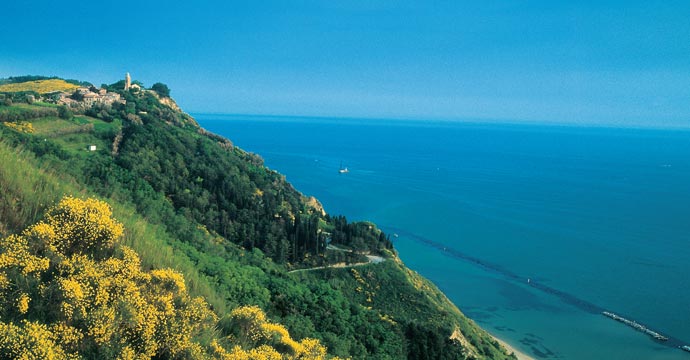Nature around Fano

The scent of salt air on the coast and the thousands of shades of blue sea, the multifaceted colors of lush flora: the Marche region has a green heart worth discovering, from the Frasassi Caves to nature parks, from the geological sites of the Furlo Gorge to the wolves of the Apennines.
Watch the video
Archilei House
Casa Archilei, an environmental education center conceived by Fano’s nature associations and established in 1989 by the Fano City Council, which made available an old farmhouse and the surrounding area with about 1.3 hectares of land. The purpose of Casa Archilei is to give birth to a center in which to bring together energies and experiences of environmental sector volunteers for practical projects and actions for the benefit of the community.
The various activities that take place at Casa Archilei-student environmental education, specialized library, database on the Metaurus basin, weather observations, reconstruction of natural environments, assistance to animals in distress, organic vegetable garden, etc.-have as their methodology that of “learning by doing,” thus enhancing active learning and curiosity about nature and the scientific world.
Casa Archilei is managed by a committee of which both public agencies and nature associations Argonauta, Kronos and ENPA are members. It is part of the project “Fano, the city of children” and in 1996 was recognized as a Territorial Laboratory of the Marche Region.
INFORMATION
Archilei House via Ugo Bassi, 6
ph. +39 0721 805211
archilei@mobilia.it
www.archilei.it
Furlo Canyon – Acqualagna
Traveling along the Flaminia in the Fano-Rome direction, it is inevitable to pass under the Furlo tunnel, located at the foot of the Canyon of the same name that bisects what was once a single massif.
For millions of years the Candigliano River has plowed through it, leaving a deep rift in its path. It is also for this reason that our mountains contain a surprising variety of interesting elements. First among them is definitely nature.
Furlo is home to wild animals of great ecological value (Wolf, Golden Eagle, Montagu’s Harrier, Peregrine Falcon, Sparrowhawk, Chough, Wallcreeper) and plants of botanical interest (Moehringa papulosa, Salix apenninica…). Not to mention the 2,500 hectares of state forests, the two Floristic Areas that are real biological sites under construction.
In this stupendous natural setting, enjoy a wonderful journey into the history of the earth, through the geological successions visible on the limestone walls of the gorge.
Other interesting elements include the ancient farming tradition, from which the recent truffle-related culinary culture derives. The Furlo Mountains and nearby Acqualagna are counted among the leading producers of black truffles and fine white truffles in central Italy.

San Bartolo Park
More than 1,600 hectares divided between the municipalities of Pesaro and Gabicce Mare, this is the extent of the San Bartolo Natural Park, which emerges from the low beaches of Romagna-Marches in an undulating succession of spurs and valleys, interspersed with striking sheer cliffs. The major peaks, Mount Castellaro and Mount Brisighella touch 200 meters, but still allow a wide view of the coast and the sea, and the sheer cliffs provide an unusual seascape amidst our predominantly sandy coastline. The cliff facing the sea shows geological aspects of great interest; fossil fish and rare chalk crystals can be seen. At the base of the cliff runs a thin beach of gravel and pebbles, the result of the collapse of the walls above.
In addition, the San Bartolo Park has examples of flora, vegetation and fauna of rare interest. Prominent among these is the flowering of fragrant gorse, which in May colors the slopes of the hills overlooking the sea with yellow. The vegetation features mostly ‘pioneer’ plants, but there is no shortage of small forests enhanced by the presence of turkey oak. Also relevant is the fauna, in winter especially, various species of seabirds are seen, such as lesser loon, porbeagles, tufted cormorant, greylag goose, black-tailed duck, sea killer whale, and others.

Simone and Simoncello Park
Continuing toward the Pesaro hinterland, it is possible to visit another nature park full of pleasant surprises for the curious tourist and also for those who usually engage in challenging hikes in the green. Located in the heart of Montefeltro, in an area rich in historical evidence and of particular naturalistic value, the Simone and Simoncello Regional Nature Park extends occupying part of the area of several municipalities: Carpegna, Frontino, Montecopiolo, Pian di Meleto, Pennabilli and Pietrarubbia.

Frasassi Caves and Gola della Rossa Park
The Caves, located in Genga, constitute an underground complex defined as one of the most beautiful in the world. The CAI Speleological Group of Ancona discovered them in 1971, and already three years later it was decided to open to the public what immediately appeared to be a treasure of inestimable value, an attraction with rare evocative power. Over the years, the path intended for visitors has been corrected and improved to accentuate the colors and shapes of the concretions, stalactites and stalagmites, as well as the natural water features and majestic vaults, with the right scenic devices. It is possible to visit the Caves throughout the year, with the exception of January 1, December 4 and 25.
Frasassi has been part of the Gola della Rossa e di Frasassi Regional Natural Park, the largest regional protected area, since 1997. A trip to the Park is a journey of discovery of historical and artistic treasures, concealed by landscapes full of charm and harmony, surrounded by intact and lush nature.
The natural sceneries are included in a larger area, that of the Esino-Frasassi Mountain Community, and the municipalities involved in the park area are Arcevia, Fabriano, Genga and Serra San Quirico, centers of multiple historical, archaeological and cultural riches.
